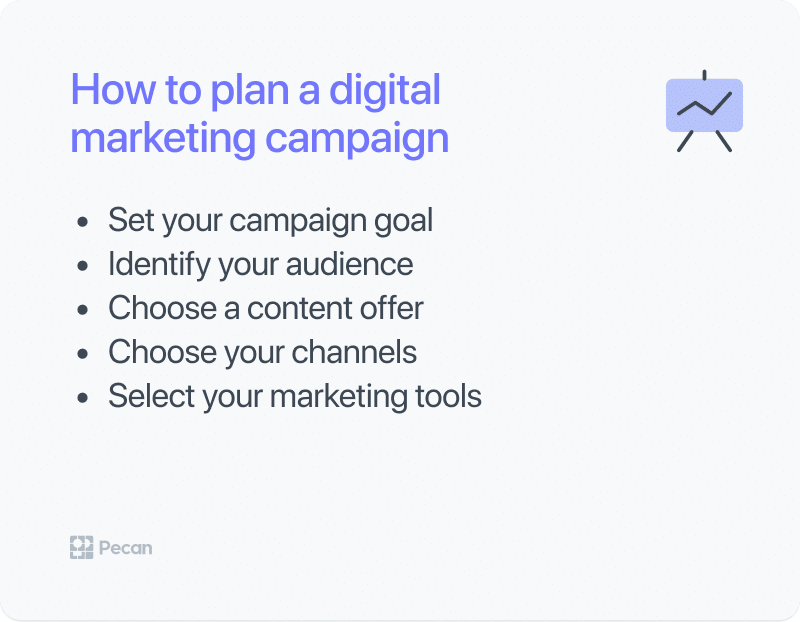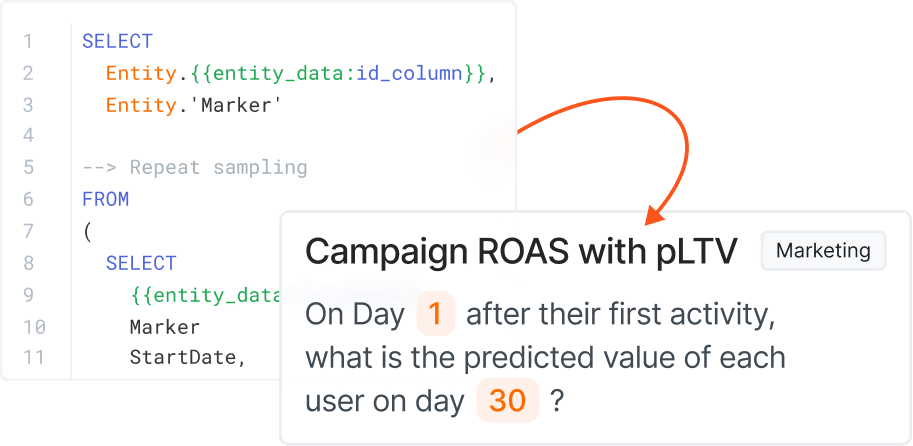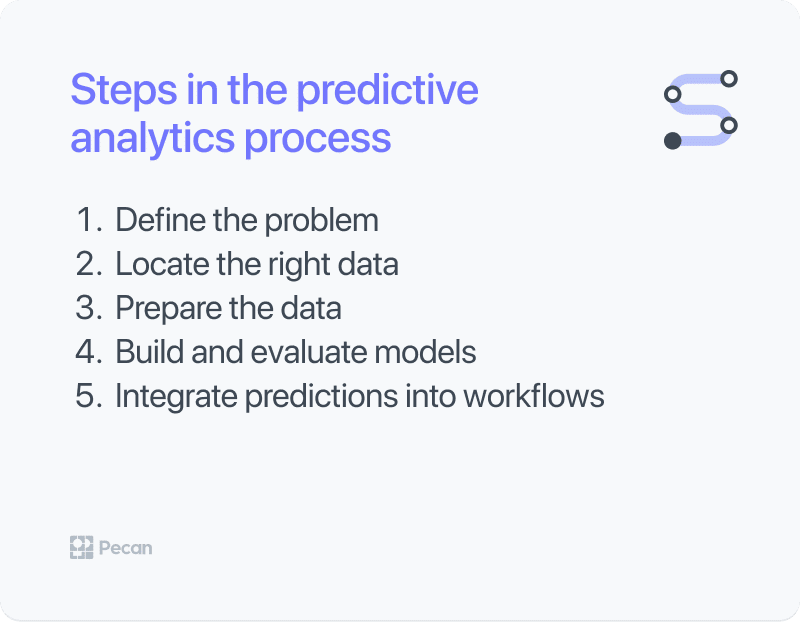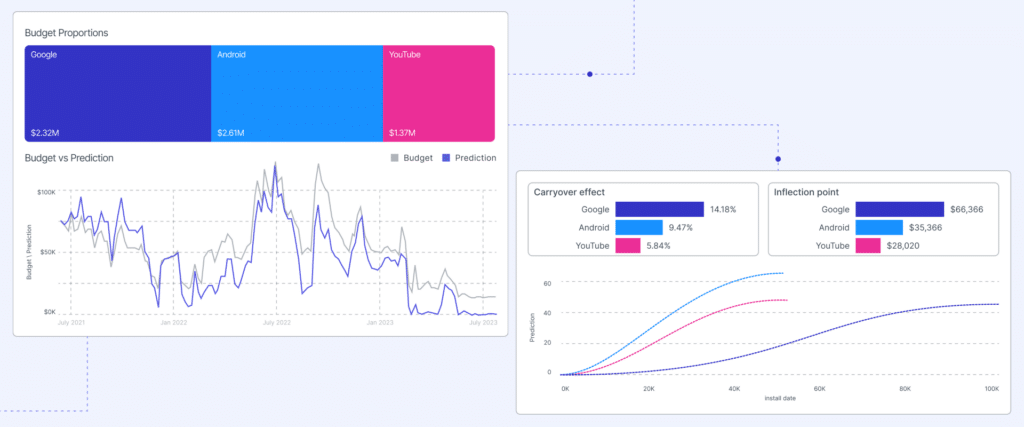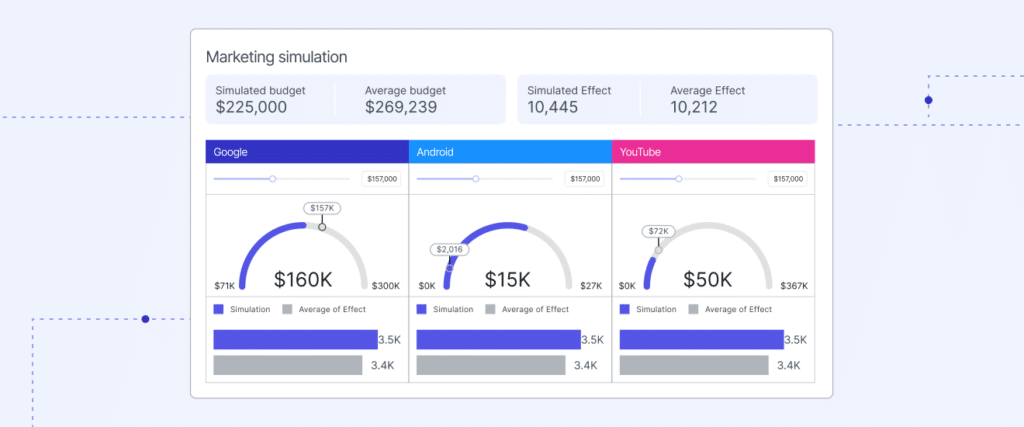As marketing budgets dwindle and third-party cookies face extinction, digital marketers are searching for new ways to grab their customers’ attention — and keep it. Attribution, personalization, and artificial intelligence (AI) top the list of concerns and trends digital marketing teams face in 2023.
To stay at the top of their game, digital marketing managers must increasingly use data analytics to cultivate deep customer knowledge and create informed marketing strategies. This guide will show you how predictive analytics can help you increase your digital marketing campaign effectiveness.
What is digital marketing?
Digital marketing is any kind of marketing conducted through a digital channel. Digital marketers use a range of online channels to reach consumers, including social media, email, text messages, search engines, display ads, and more.
Digital marketing managers may use any combination of three overarching types of channels.
- Owned media channels are any marketing channels that businesses have sole ownership and control over, like a website or social media profile.
- Paid media channels require paying money for exposure, such as paid search, paid social, or programmatic media.
- Earned media is any kind of exposure or marketing generated by people outside of the company. Examples include word-of-mouth marketing, guest blogs, and guest appearances on webinars or podcasts.
For digital marketing managers in business-to-business (B2B), the ultimate goal of digital marketing is to drive customers to their website to speak directly with a salesperson. This may require prospects filling out a form with their personal information to access a piece of content, whether that’s a report, white paper, e-book, webinar, etc.
For business-to-consumer (B2C) and direct-to-consumer (DTC) businesses, digital marketers’ main goal is to drive customers to their websites to convert them without ever needing to speak to a salesperson, usually through an on-site checkout function or a mobile app.
Digital marketers must decide which channels are best for reaching their audiences and achieving their goals. For example, a DTC company selling niche apparel for millennials may prioritize paid native advertisements on Facebook or Instagram. They would then ensure their ads are relevant to their target audience. These digital ads would guide customers to a website or a mobile app where prospects could shop and make purchases (convert).
A highly relevant, targeted ad presented on the right channel will increase the chances of customers clicking on that advertisement and converting. Similarly, a mobile game maker may advertise on Facebook to find people who will install and engage with their game. Successful mobile game campaigns would ideally bring in users who not only install the game but also become paying users or subscribers.
The four steps involved in a digital marketing campaign
A digital marketing campaign is a coordinated sequence of online marketing activities over a set period of time to achieve a specific goal. This may include multiple kinds of digital marketing, including email marketing, social media marketing, SEO, paid digital advertisements, and content marketing. There are four steps involved in creating any digital marketing campaign.
Step 1: Plan your digital marketing campaign
Before starting a new campaign, you must establish a clear digital marketing strategy.
- Set your campaign goal. First, decide what you’re trying to achieve with your campaign. For example, if you’re running a digital marketing campaign in Q1 and need to drive 1,000 sales of a certain item on your preferred selling platform, you may decide how many site visitors you need to reach that number of conversions. By clearly defining your objectives, you can map out clear steps to achieve them.
- Identify your audience. After setting a specific goal, decide who you’re going to market to. Ideally, your organization already has a list of ideal customers or users, and you would select your audience from this list. An ideal customer profile (ICP) is a semi-fictional representation of your ideal customer or user that includes important information such as their demographics, challenges, day-to-day responsibilities, motivations, and goals. If your organization does not have ICPs ready, you will have to do some research to create your own.
- Choose a content offer. For a B2C or DTC audience, you will want to select a product or offering to advertise that solves a unique challenge for your ICP or meets a unique want or need. For example, marketing campaigns for most global gaming companies focus on driving app installs. To do so, they leverage engaging parts of their game to entice players to download and start playing.
- Choose your channels. Whether you send out an email blast or run native ads on social media, keep in mind where your target audience is most likely to hang out. Remember, all advertising is intrusive by nature. To stand out, make sure your advertisements are relevant, engaging, valuable, and even entertaining.
- Decide which marketing tools you’re going to use. Digital marketers have more tools available than ever. These solutions could include anything from keyword optimization software to email management software to predictive analytics software that can boost your campaign performance. The best tools are easy to use and will help you take data-driven action quickly to improve marketing performance.
Step 2: Manage your digital marketing campaign
Once you’ve laid the groundwork, the next steps are to produce your assets (if necessary) and then launch your campaign.
- Oversee any production. As a digital marketing manager, it may be your responsibility to oversee content creation, or at least submit a request to an agency or the internal stakeholders responsible for content creation. This may include writing, designing, or animating a piece of content or a video.
- Launch your campaign. Once your content is ready and you’re set up with the appropriate tools and channels, it’s time to launch your digital marketing campaign. Ideally, your campaign will last for a specified amount of time. The newer the campaign and tactics involved, the shorter the overall run-time should be so that you can make any improvements.
Pecan’s platform can predict the LTV of users or customers you’re gaining with a campaign so you can make the best decisions.
Step 3: Optimize your digital marketing campaign
The traditional approach to campaign management and optimization involves looking at your data early on, usually after seven days, and making decisions based on that limited performance data.
For example, you may see that certain channels are working better than others. Or you may be A/B testing different messaging. ROAS (return on ad spend) is a common metric digital marketers use to evaluate the success of their campaigns.
If you’re able to get clear signals that indicate one method, approach, or message will deliver a higher ROAS, you should optimize those parts of your campaign to improve its overall success.
However, keep in mind that the data you gather may be severely limited by your ad platforms’ data provisions (which kinds of data it can collect and use). Fortunately, as we’ll discuss below, it’s possible today to navigate around many of those limitations with the help of predictive analytics software.
Step 4: Report on your digital marketing campaign
By gathering and analyzing the data from your campaign, you’ll be able to see what went well and what didn’t — and learn how to improve the effectiveness of any future campaigns.
Which metrics you analyze and measure will depend on which channels you’re using and how effective your analytics are. For email marketing, digital advertisements, and social advertisements, you might prioritize click-through rates. Or you may have an overarching goal such as increasing brand awareness.
Focus your reporting on relevant metrics, like ROAS, that are closely related to the success of your campaign. The better your data and reporting capabilities, the more likely you’ll be able to increase your future campaign performance.
How predictive analytics helps improve digital marketing campaigns
Our State of Predictive Analytics in Marketing survey research revealed that over half of marketing leaders feel their ability to predict customer behavior is always or often “guesswork.” That feeling persists despite many companies’ significant investments in data infrastructure, teams, and tools (many marketing teams have upward of 18 data tools). At most organizations, “data-driven decision-making” has too often become an empty promise.
Data analytics is crucial to improving your digital marketing efforts. Not only does this include analyzing historical data — such as the results of a campaign — but it also includes predicting how customers will behave.
A future-focused approach to digital marketing campaign management would incorporate predictions about what’s likely to occur in the next 30, 60, 90, or 180 days, or even further out.
This approach would far better anticipate the likely ROAS of campaigns and predict optimal budget allocation. But gaining these predictive insights hinges on having accessible predictive analytics.
What is predictive analytics?
Predictive analytics is a problem-solving approach that looks at historical patterns to generate informed predictions. It uses data, statistics, and machine learning techniques to build mathematical models that can generate predictions about things likely to happen in the future.
Instead of relying on “best guesses” about the future based on historical data, digital marketing teams can use these more accurate predictions based on thousands (or billions) of data points to inform their campaigns.
The five steps of the typical predictive analytics process
- Identify and define a business problem that can be addressed with data. What do you want to predict? Do you have data that relates to this issue?
- Locate and gain access to the data. Who is in charge of the data you’ll need, and where is the data stored?
- Clean and prepare the data. In a perfect world, all data would be ideally formatted for your needs and contain no errors or issues that present statistical challenges. In reality, data often needs a fair amount of cleaning and “wrangling” to be ready for predictive analytics
- Build and evaluate multiple mathematical models from the data. Test how well they make predictions on fresh data that wasn’t used in the building process. Adjust the models until they produce results that actually offer business value.
- Integrate the model’s predictions into your business workflows, actively using the predictions to guide business decisions. Monitor and update the model as needed, and assess how it’s contributing to your desired business outcomes.
That’s a lot of steps. But data experts have developed tools that streamline this entire process for digital marketing teams who don’t want to handle the nitty-gritty details.
While some steps are still the same — for example, you’ll still need to get access to your data and coordinate with those who manage it — other steps are far more simple, thanks to automated low-code predictive analytics platforms.
How to create more effective digital marketing campaigns with predictive analytics
Predictive analytics can help you improve every step of your digital marketing campaigns, from planning to reporting. Predictive analytics can even estimate ad revenue to help you optimize your marketing channels early in a campaign. In a nutshell, predictive analytics helps you see beyond historical data into the (probable) future to make precise marketing decisions for your campaigns and maximize your ROAS.
Predictive analytics for marketing results
Allocate budget to channels using models (marketing mix modeling)
First-touch, last-touch, time-decay, W-shaped, multi-touch, and beyond: Attribution methods have evolved over the years. The more sophisticated an organization’s digital marketing function, the more advanced types of attribution they’re likely to use.
But changes in iOS, the SKAdNetwork, and the impending loss of third-party cookies have disrupted widely adopted measurement and attribution strategies, making it difficult for digital marketers to allocate their budget and prioritize channels. (This also makes it more critical for digital marketers to prioritize first-party data.)
In addition, leading analysts have said that adding four or more channels to an integrated campaign will increase results by 300%. As brands add more channels to reach their buyers, measurement becomes more and more complicated.
Pecan’s MMM solution reveals channel saturation and carryover effects, plus additional insights.
Digital marketing managers can future-proof their marketing strategies with marketing mix modeling (MMM). MMM is a statistical model that businesses have used for decades, but with the help of machine learning, MMM can provide much faster and more accurate, granular, and actionable insights.
That’s because MMM isn’t affected by changes in the mechanics of ad platforms and channels. It uses channel-level data to provide a straightforward prediction of how much money should be allocated to each channel to achieve your desired result.
MMM bypasses the many complications of obtaining and analyzing user-level data. It also helps digital marketing managers make strategic budget decisions throughout their campaigns.
Best-in-class Marketing Mix Modeling — driven by advanced machine learning — utilizes fast-moving and granular optimizations to improve marketing ROI by 14-38%.“Growth through Privacy-First Measurement,” Accenture
Predictive analytics for campaign management & optimization
Once you’ve dialed in the ideal allocation of budget to your different marketing channels, the work isn’t done. The campaigns you run within those channels can also benefit from further optimization.
Your marketing team members should perform conversion rate and campaign optimization on a weekly, if not daily, basis. This optimization allows you to adjust bids properly, refine your audiences, and ensure efficiencies in performance marketing initiatives.
But managing an ad campaign using typical methods can take weeks, if not months, to generate enough data to optimize. Additionally, many marketing teams still use data tools, like BI-driven dashboards, that don’t provide capabilities for agile, fast-paced decision-making with data. That means it’s hard to respond quickly to today’s volatile market and make data-driven decisions about what to do in the near future.
Predictive analytics for ROAS
As mentioned earlier, ROAS (return on ad spend) is the marketing metric that measures the revenue returned on the amount spent on advertising campaigns. Predictive analytics supports ROAS goals by allowing campaign managers to act faster.
Managers are also better informed by using customer-level predictions based on the future value of a customer. With predictive insights, marketing teams can optimize ad campaigns sooner after launch — even within the first 24 to 48 hours — instead of waiting two to four weeks for a campaign to mature.
Predicting campaign ROAS gives you foresight about a campaign’s long-term potential. These predictions give your team invaluable knowledge of the future and insight into how your campaigns will reach marketing goals and organizational KPIs.
Driving higher ROAS is vital to helping your business reach new customers and retain and exceed growth targets. Identifying which campaigns will help you do this earlier in the campaign lifecycle will help you better use your budget for maximum results.
In addition to using customer lifetime value to support ROAS, digital marketing managers can use conversion rate modeling. With automated predictive analytics software, conversion rate modeling can instantly help digital marketers create tailored conversion strategies that emphasize offline interactions and help meet their specific goals.
Looking at your customer base from a future-value perspective gives you a clearer picture of the lifetime value of your customers or users. With this foresight, you can create longer-term revenue and profitability and shape a stickier customer experience.
Optimizing campaigns with predictive events
If you advertise on Google, Facebook, or any other demand-side platform, you’ve likely seen your cost per thousand impression rates increase significantly since 2019. Furthermore, as these platforms continue to change their data usage policies, ad tracking, and measurement capabilities, it’s becoming harder to find the right audiences and attribute success. Advertisers are left with few insights to optimize a campaign, but the pressure to deliver results is still intense.
Fortunately, a predictive analytics approach offers a vital glimpse of the future that can guide these optimization decisions. Predictive analytics can help marketing teams predict the future value of each customer or user who converts via your ad campaigns. This perspective differs from examining the conversion cost or the served impression’s present value.
This strategy can work in various industries, including direct-to-consumer and e-commerce, apps and gaming, insurance, and financial services — anyone who takes advantage of programmatic advertising.
For example, if you are advertising a mobile app or game, your ad platforms need strong signals to find ideal audiences. You can enhance your descriptive events with future-informed predictive events, then send those predictive events to marketing channels to automatically optimize your campaigns for high-quality users — sooner and at a lower price.
Your competitors using event data from day 7 or earlier won’t recognize the high-value users who convert later. With predictive events, you can optimize campaigns to reach those lower-cost, high-ROI users more quickly and efficiently. These predictive events can also be incorporated into your SKAdNetwork conversion schema for much more efficient optimization of iOS campaigns.
Start optimizing your digital marketing budget and campaigns with Pecan AI
Pecan is a low-code predictive analytics solution that puts the power of AI in the hands of business people. We help your marketing teams predict mission-critical customer acquisition and engagement outcomes — all without requiring any PII or data scientists on staff. Using Pecan’s secure platform, companies turn hindsight into foresight by generating highly accurate predictions for revenue-driving KPIs in just weeks.
With Pecan, you can save millions on advertisements and predict customer behavior to double your conversion rates. Learn more about how Pecan AI can help you build better digital marketing campaigns, and see how other marketers are increasing their campaign effectiveness with predictive insights.
Watch how Pecan AI removes the guesswork from your growth and makes your data more valuable. Schedule a live demo today!

